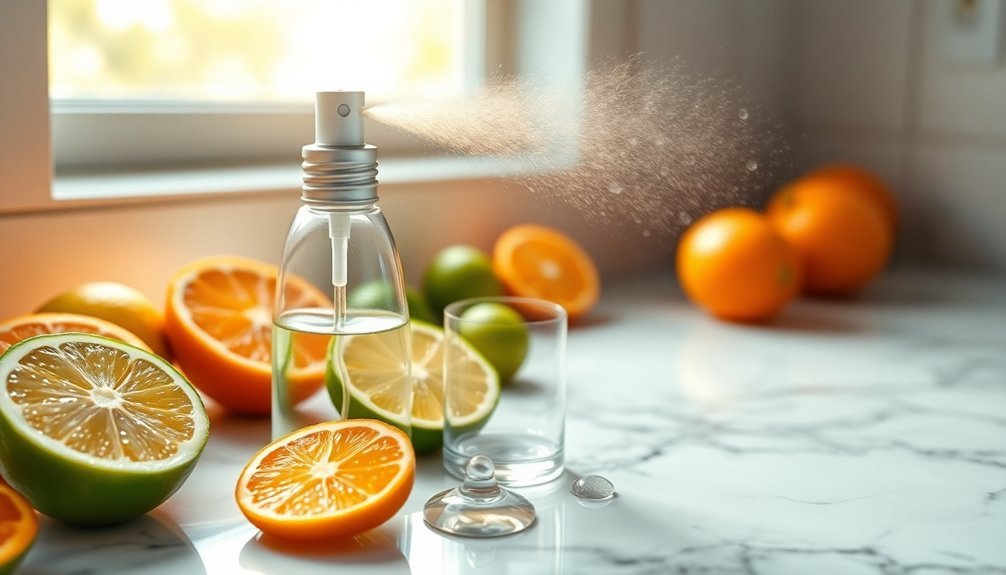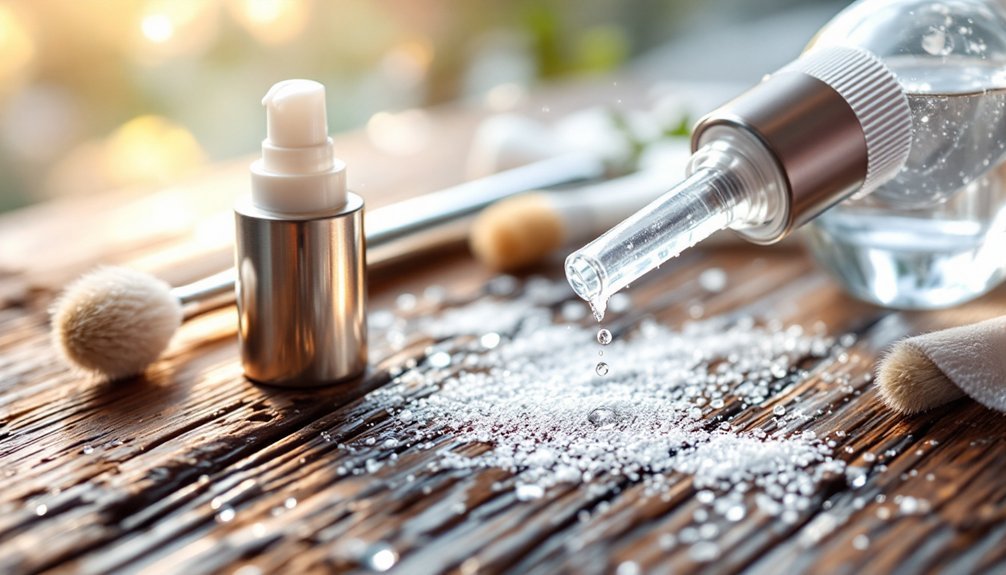You'll find three highly effective methods to clean your perfume atomizer: a soap-and-water deep clean for basic maintenance, an alcohol-based sanitizing technique for thorough disinfection, and a natural citrus solution for gentle degreasing. Each approach requires disassembling the atomizer, cleaning all components thoroughly, and allowing them to air dry completely. Proper cleaning prevents fragrance contamination and maintains peak spray performance – discover which method best suits your collection.
The Quick Soap-and-Water Deep Clean Method

Maintaining your atomizer's cleanliness doesn't have to be complicated. With mild dish soap and warm water, you'll keep your perfume sprayer in top condition while preventing residue buildup.
Start by disassembling all components, including the spray nozzle and cap. Give them an initial rinse under running water, then soak the parts in your diluted soap solution.
Before cleaning your atomizer, take it apart completely and rinse each piece before soaking them in soapy water.
Use a soft-bristled brush to gently scrub away stubborn residue, and reach tight spots with cotton swabs or pipe cleaners. Never use sharp objects that could damage the delicate mechanisms. Similar to vaping atomizers, regular cleaning prevents buildup that could affect spray performance.
Once clean, rinse thoroughly with warm water and let all parts air dry completely. You should perform this cleaning at least monthly or whenever you switch fragrances.
This simple method will extend your atomizer's life while ensuring each spray delivers pure, uncontaminated perfume.
The Professional Alcohol-Based Sanitizing Technique
While soap and water work well for basic cleaning, professional-grade sanitizing requires a more robust approach. You'll need high-proof alcohol (190 proof) to effectively remove stubborn fragrance residues and prevent bacterial growth in your atomizer.
Start by disassembling your atomizer and using alcohol-dipped cotton swabs to clean the pump, tube, and nozzle. Pay special attention to hard-to-reach areas, but don't use sharp objects that could damage the components. Monthly cleaning is recommended to maintain optimal performance and prevent clogging.
Once you've removed all visible residue, rinse thoroughly with warm water to eliminate any alcohol traces.
Let all parts air dry completely – avoid using heat, as it can damage the atomizer. For extra protection, consider using a UV disinfecting cabinet. This method is particularly effective when switching perfumes, especially if you're using plastic atomizers that tend to retain scents.
The Natural Citrus Solution Degreasing Process

For those seeking an eco-friendly alternative to chemical cleaners, natural citrus solutions offer a powerful way to degrease and refresh your atomizer.
You'll find that citrus peels contain limonene, a natural solvent that effectively dissolves residue while leaving a pleasant scent. Simply combine your chosen citrus peels with white vinegar and let them infuse for 1-2 weeks. The mixture serves as an effective odor neutralizer while cleaning your atomizer components.
- Store extra citrus peels in your freezer until you've collected enough
- Mix different citrus types like lemon and orange for a unique fragrance
- Dilute your concentrated solution with water for gentler cleaning
- Rinse thoroughly before reusing your atomizer
When applying the solution, make sure you don't oversaturate the nozzle to prevent clogging.
This natural method works especially well for removing old perfume residue while being environmentally responsible.
Frequently Asked Questions
How Often Should I Replace My Perfume Atomizer Even With Regular Cleaning?
You'll need to replace your atomizer every 6-12 months if you're using it daily, even with regular cleaning. Watch for signs like uneven spray patterns, leaks, or persistent residue to determine replacement timing.
Can Extreme Temperatures Damage My Atomizer While Cleaning?
Yes, extreme temperatures can damage your atomizer. You'll want to stick to lukewarm water when cleaning, as very hot or cold temperatures can warp materials, affect metal components, or crack glass parts.
Is It Safe to Clean Multiple Atomizers in the Same Cleaning Solution?
You can clean multiple atomizers in the same solution, but it's best to change it frequently to avoid cross-contamination. You'll want to guarantee thorough rinsing between different fragrances to maintain purity.
Which Cleaning Method Works Best for Vintage or Antique Perfume Atomizers?
You'll get the best results using a dilute vinegar solution and cotton swabs for gentle cleaning. Don't use harsh chemicals that could damage antique materials, and always preserve original labels while cleaning.
Should Different Cleaning Methods Be Used for Metal Versus Plastic Atomizers?
Yes, you'll need different methods. Use warm soapy water or rubbing alcohol for metal atomizers, but stick to mild soap solutions for plastic ones to avoid damage. Avoid harsh chemicals on plastic components.





Leave a Reply